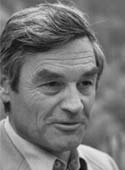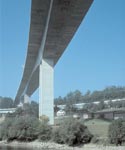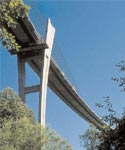 Felsenau Bridge
Felsenau Bridge
 LEARN
MORE...
LEARN
MORE...
Learn about Menn's innovative design
for the Sunniberg Bridge.
Sunniberg Bridge
 |
|
SWISS
ENGINEERS
CHRISTIAN MENN
“[S]uccessful design of a perfect structure
can never be performed only on the basis of general rules concerning
structural system, dimensions and proportions alone, as long as the
design lacks in originality and individuality.”
Christian Menn (born 1927) entered the Eidgenössische
Technische Hochschule (Federal Institute of Technology) in 1946
and two years later began taking classes from Lardy. Following graduation,
he entered the Swiss military service. In 1951 he contracted tuberculosis
and spent fourteen months in a sanatorium where he began theoretical
studies on the structural analysis of spiral staircases. Upon his recovery,
he accepted an offer to assist Professor Lardy, with whom he spent the
next three years (1953–56) at the ETH. He, along with two others,
acted as the usual teaching assistant for Lardy’s courses and
helped Lardy with his research and consulting. In addition, he completed
his dissertation and in 1956 received the doctoral degree with Lardy
as his principal advisor.
Menn’s earliest bridges were relatively long-span deck-stiffened
arches in the tradition of Maillart, but eventually the revolutionary
new material—prestressed concrete—began to open up a new
vision of design for him. He saw that prestressing could actually replace
the arch itself. The deck of his arch bridge could then become the main
supporting member without the arch. Moreover, during construction, no
scaffolding would be needed to support the arch and no curved formwork
would be required to shape it.
The Felsenau Bridge is an example of such a
design, which dispenses with the arch form and carries the roadway solely
by a curved hollow-box beam that has been prestressed. The effect is
a structure of exceptional lightness, a stripped-down form of transparency
that satisfies all three of Menn’s main criteria for design: efficiency,
economy, and aesthetics.
One of the uncommon features of the Felsenau design is the single box
for a wide roadway. Previously, prestressed segmental bridges had two
boxes, one for each half of the bridge. The single box with wide cantilever
slabs requires less material than would two boxes; however, those two
transverse cantilevers could have caused deflection problems had Menn
not decided to use partial prestressing. The slabs are transversely
prestressed for dead load only, and additional non-prestressed steel
resists the live load. In this way the permanent loads are balanced,
and there is little tendency for vertical deflection caused by creep
under prestress-induced bending. At the same time, some cracking is
tolerated under full live load, as it would be in a normally reinforced
concrete structure. Compared to a double box, the single box has the
cost-saving advantage of halving the forming operations and allowing
the cantilever slabs to be built at a later time on simple scaffolding
supported from the completed box girder.
GLOSSARY
I ACKNOWLEDGMENTS
I RELATED
LINKS
© 2003 The Princeton
University Art Museum |
|







